Related Research Articles
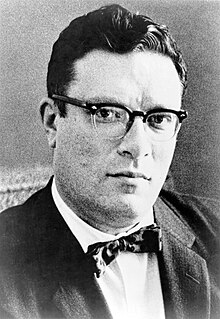
Isaac Asimov was an American writer and professor of biochemistry at Boston University. He was known for his works of science fiction and popular science. Asimov was a prolific writer, and wrote or edited more than 500 books. He also wrote an estimated 90,000 letters and postcards.
The Galactic Empire series is a science fiction sequence of three of Isaac Asimov's earliest novels, and extended by one short story. They are connected by their early place in his published works and chronological placement within his overarching Foundation Universe, set around the rise of Asimov's Galactic Empire, between the Robot and Foundation series to which they were linked in Asimov's later novels.
"Blind Alley" is a science fiction short story by American writer Isaac Asimov. It was first published in the March 1945 issue of Astounding Science Fiction, and later included in the collection The Early Asimov (1972).
"Reason" is a science fiction short story by American writer Isaac Asimov, first published in the April 1941 issue of Astounding Science Fiction and collected in I, Robot (1950), The Complete Robot (1982), and Robot Visions (1990). It is part of Asimov's Robot series, and was the second of Asimov's positronic robot stories to see publication.
The Red Queen's Race is a science fiction short story by American writer Isaac Asimov; it uses the Red Queen's race from Lewis Carroll's Through the Looking-Glass as a metaphor for the final plot twist. The story also makes reference to Asimov's psychohistory. "The Red Queen's Race" was first published in the January 1949 issue of Astounding Science Fiction and reprinted in the 1972 collection The Early Asimov.
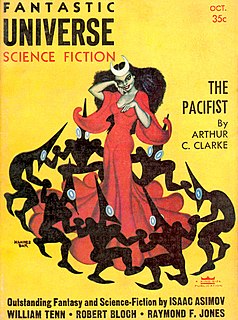
"First Law" is a science fiction short story by American writer Isaac Asimov, first published in the October 1956 issue of Fantastic Universe magazine and later collected in The Rest of the Robots (1964) and The Complete Robot (1982). The title of the story is a reference to the first of the Three Laws of Robotics.
Pâté de Foie Gras is a 1956 science fiction short story by American writer Isaac Asimov, originally published by Astounding Science Fiction.
"Victory Unintentional" is a humorous science fiction short story by American writer Isaac Asimov, published in the August 1942 issue of Super Science Stories and included in the collections The Rest of the Robots (1964) and The Complete Robot (1982).
"Not Final!" is a science fiction short story by American writer Isaac Asimov, originally published in the October 1941 issue of Astounding Science Fiction, and included in the 1972 collection The Early Asimov. Its sequel, "Victory Unintentional", is a robot story. These are two of the few stories by Asimov to postulate non-human intelligences in the Solar system.
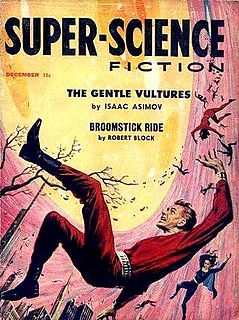
"The Gentle Vultures" is a science fiction short story by American writer Isaac Asimov. The story first appeared in the December 1957 issue of Super-Science Fiction, and was reprinted in the 1959 collection Nine Tomorrows.
"Trends" is a science fiction short story by American writer Isaac Asimov. It was first published in the July 1939 issue of Astounding Science Fiction and was reprinted in Great Science Fiction Stories About the Moon (1967) and The Early Asimov (1972).

Sucker Bait is a science fiction novella by American writer Isaac Asimov. It was first serialized in the February and March 1954 issues of Astounding Science Fiction, and reprinted in the 1955 collection The Martian Way and Other Stories. It has also been adapted as an episode of the BBC anthology television series Out of the Unknown.
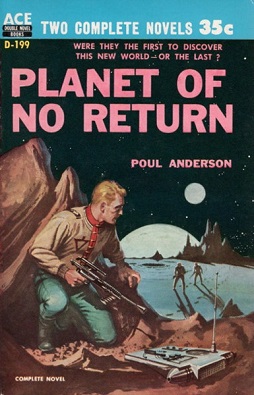
Question and Answer is a science fiction novel by American writer Poul Anderson. It originally appeared in the June and July 1954 issues of magazine Astounding Science Fiction, and was later reprinted in 1956 as part of Ace Double D-199 under the title Planet of No Return, and again as a stand-alone Ace novel in February 1978 under the original title.
"Homo Sol" is a science fiction short story by American writer Isaac Asimov. It was first published in the September 1940 issue of Astounding Science Fiction and reprinted in the 1972 collection The Early Asimov. It deals with the proposed acceptance into a galactic federation of hominid civilizations of the hominids of newly discovered Earth.
"Half-Breed" is a science fiction short story by American writer Isaac Asimov. It was first published in the February 1940 issue of Astonishing Stories and reprinted in the 1972 collection The Early Asimov. It was the fifteenth story written by Asimov, and the fourth to be published. At 9000 words, it was his longest published story to date.
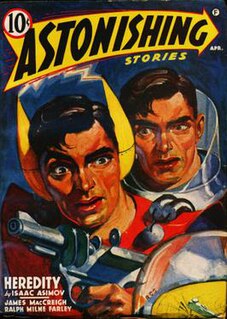
"Heredity" is a science fiction short story by the American writer Isaac Asimov. Asimov wrote the story, his twenty-third, in August 1940 under the title "Twins". It was rejected by John W. Campbell, editor of Astounding Science Fiction, on 29 August, and accepted by Frederik Pohl on 4 September. It appeared in the April 1941 issue of Astonishing Stories under the title "Heredity" and was reprinted in the 1972 collection The Early Asimov. Heredity was the second Asimov story to receive a cover illustration.
"Death Sentence" is a science fiction short story by American writer Isaac Asimov. It was first published in the November 1943 issue of Astounding Science Fiction and reprinted in the 1972 collection The Early Asimov.
"Time Pussy" is an early science fiction short story by American writer Isaac Asimov.

"The Blue Giraffe" is a science fiction story on the concept of mutation by American writer L. Sprague de Camp. It was first published in the magazine Astounding Science-Fiction for August, 1939. It first appeared in book form in the anthology Adventures in Time and Space ; it later appeared in the anthologies World of Wonder, The Science Fiction Bestiary, Androids, Time Machines and Blue Giraffes, Isaac Asimov Presents the Great Science Fiction Stories: Volume 1, 1939, Isaac Asimov Presents The Golden Years of Science Fiction, and An Anthropomorphic Century. The story has been translated into Italian, French and German.
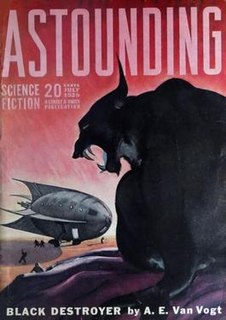
"Black Destroyer" is a science fiction short story by Canadian-American writer A. E. van Vogt, first published in Astounding SF in July 1939. It has been marked as the story that represents the start of the Golden Age of Science Fiction.
References
- ↑ Asimov, Isaac (1972). The early Asimov; or, Eleven years of trying. Garden City NY: Doubleday. pp. 466–470.